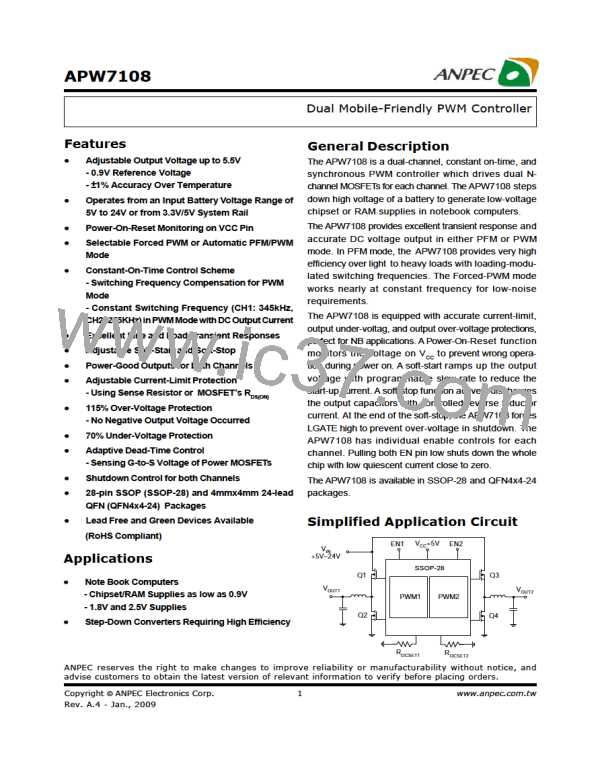APW7108
Function Description
critical conduction point). The on-time of PFM mode is
designed at 1.5 time of the nominal on-time of PWM
mode. The on-time of PFM is given by:
Constant-On-Time PWM Controller with Input Feed-
Forward
The constant-on-time control architecture is a
pseudo-fixed frequency with input voltage feed-
forward. This architecture relies on the output filter
capacitor’s effective series resistance (ESR) to act as a
current-sense resistor, therefore, the output ripple volt-
age provides the PWM ramp signal. In PFM operation, the
high-side switch on-time controlled by the on-time gen-
erator is determined solely by a one-shot whose pulse
width is inversely proportional to input voltage and di-
rectly proportional to output voltage. In PWM operation,
the high-side switch on-time is determined by a switch-
ing frequency control circuit in the on-time generator block
for each channel. The switching frequency control circuit
senses the switching frequency of the high-side switch
and keeps regulating it at a constant frequency in PWM
mode. The design improves the frequency variation and
is more outstanding than a conventional constant-on-time
controller which has large switching frequency variation
over input voltage, output current and temperature. Both
in PFM and PWM, the on-time generator, which senses
input voltage on VIN pin, provides very fast on-time re-
sponse to input line transients.
1.5 VOUT
TON - PFM =
´
FSW
V
IN
Where FSW is the nominal switching frequency of the con-
verter in PWM mode.
This design provides a hysteresis of converter’s output
current to prevent wrong or repeatedly PFM/PWM handoff
with constant output current. The load current at handoff
from PFM to PWM mode is given by:
1
2
VIN - VOUT
ILOAD(PFM toPWM) =
´
´ TON - PFM
L
V
IN - VOUT 1.5 VOUT
=
´
´
2L
FSW
V
IN
The load current at handoff from PWM to PFM mode is
given by:
1
2
VIN - VOUT
ILOAD(PWMtoPFM) =
´
´ TON - PWM
L
V
IN - VOUT
1
VOUT
=
´
´
2L
FSW
V
IN
Therefore, the ILOAD(PFM to PWM) is 1.5 time of the ILOAD(PWM to PFM)
.
The on-times for channel 2 are set 35% higher than the
on-times for channel 1. This is done to prevent audio-
frequency “beating” between the two sides, which
switch asynchronously for each side.
Forced PWM Mode
The forced-PWM mode disables the zero-crossing
comparator, which controls the low-side switch on time.
This causes the low-side gate-drive waveform to
become the complement of the high-side gate-drive
waveform. This in turn causes the inductor current to
reverse at light loads while UGATE maintains a duty fac-
tor of VOUT/VIN. The benefit of forced-PWM mode is to keep
the switching frequency fairly constant. Forced-PWM
mode is the most useful for reducing audio frequency
noise, improving load-transient response, and providing
sink-current capability for dynamic output voltage
adjustment.
Another one-shot sets a minimum off-time (typical:
550ns). The on-time one-shot is triggered if the error
comparator is high, the low-side switch current is be-
low the current-limit threshold, and the minimum off-
time one-shot has timed out.
PFM Mode
In PFM mode, an automatic switchover to pulse-fre-
quency modulation (PFM) takes place at light loads.
This switchover is effected by a comparator that truncates
the low-side switch on-time at the inductor current’s
zero crossing. This mechanism causes the thresh-
old between PFM and PWM operation to coincide
with the boundary between continuous and discon-
tinuous inductor-current operation (also known as the
Power-On-Reset
A Power-On-Reset (POR) function is designed to prevent
wrong logic controls when the VCC voltage is low. The
POR function continually monitors the bias supply volt-
age on the VCC pin if at least one of the enable pins is
Copyright ã ANPEC Electronics Corp.
17
www.anpec.com.tw
Rev. A.4 - Jan., 2009

 ANPEC [ ANPEC ELECTRONICS COROPRATION ]
ANPEC [ ANPEC ELECTRONICS COROPRATION ]